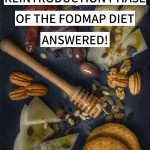
Questions answered about the reintroduction phase
A while back, I asked in the Karlijn’s Kitchen Facebook group whether you had interest in a Q&A session with a FODMAP-certified dietician and a lot of people said that they would like that. Today we answer your questions that are specifically about the reintroduction phase!
Your questions have been answered by Manon te Linde, she runs the blog Positive Gut and has her own dietitian practice in the Netherlands. She has specialised herself in helping people with gut issues, which includes IBS and the low FODMAP diet. She has IBS herself and therefore knows very well what it is like. I have done online consults with her too and she has helped me tremendously with her tips about the low FODMAP diet and other things that can impact your gut health. In this blog, she will answer questions about the reintroduction phase.
Questions about the reintroduction phase
What should I do when I react to all FODMAP groups in the reintroduction phase?
If you react to all FODMAP groups, there is a chance that you have dysbiose. Dysbiose is a disbalance of the gut bacterias and because of that your gut can be extra sensitive. If that is the case, it is important to first focus on healing your gut and then reintroduce again.
To heal your gut, it is important to eat healthy and eat enough fiber. So that your healthy gut bacterias get the right nutrition to reproduce. In some cases, it is useful to research if there are other food intolerances that play a role in your complaints, so that those can be eliminated. It is advised to always follow this process with a certified dietician.
I want to start reintroducing. For each group several test foods are suggested, such as mango and honey for fructose. What if I don’t like a certain food? Can I also take something else from that group?
Yes, you can. It is even better to test with foods that you would normally eat too. If you would test a food that you would never eat anyway, it doesn’t make so much sense. Make sure to pick a food that only contains the FODMAP group that you want to test and not any other FODMAPs.

Is it good to do the FODMAP reintroduction again after you have been following an adapted FODMAP diet for a few years? Can it be possible that you can tolerate groups now that you didn’t tolerate before?
It is advised to do the reintroduction of the groups that you reacted to again at least 1x per year. Your body changes, your gut changes, the stress level in your life changes and your eating pattern changes too. It is possible that you are able to tolerate foods again that you didn’t tolerate before, so it is definitely good to test again now and then.
What are tips against stress around the reintroduction? How can I be 100% sure that it is the food that I react to and not something else?
Stress is always something that can play a role in the reintroduction. Try to pick a day for a the reintroduction when you don’t have any important other plans. Choose a moment when you stomach is calm and make sure that you have some products available that can help to relieve your symptoms if you react to a food, such as a hot water bottle or peppermint oil.
And then you simply have to test. Try to make yourself curious for the outcome and not nervous. You are going to find out if you can eat a food again and that can also be very positive.
The only way you can be 100% sure that it was the food that you reacted to and nothing else, is by testing it more often. I know that this can be very difficult because if you were in pain, you don’t want to experience that again. But if you were not sure when you did the first test, that the test product caused the symptoms, it is necessary to test it again to be sure. Wait until your symptoms have gone away and try another time.
How do you start reintroducing?
Start reintroducing when your stomach has been calm for at least a week and you have minimal symptoms. Choose the product group that you want to start with and look up the reintroduction schedule in the Monash University app. Start with day 1 and follow the schedule.
If you have light symptoms with a reintroduction, can you conclude that you cannot tolerate it?
No, when you experience symptoms during reintroduction, you should actually always test another time to make sure that the product caused the symptoms. When you follow the testing schedule and you get light symptoms on day 1, it is always advised to continue to day 2. Only when you get very heavy symptoms they advise to end your test. But even then it might be good to give the test another try later, to make sure that it was the test food that you reacted to.
Does it matter in which order you test?
No, that doesn’t matter. You can test the groups in a order that you like.
How can you be sure that you reacted to the test food if you experienced symptoms sometimes during the elimination phase (without eating FODMAPs)?
Answer by Karlijn: if you are not sure whether you reacted to the test food or to something else, you have to test the food again. It is very important that you have your symptoms under control as much as possible when you start testing. Otherwise it is going to be very hard to find out if the reaction you get was because of the test product or because of something else.
I experienced the same thing when I was testing. I went to a dietician to figure out why I was still experiencing symptoms and worked to get them under control. Then I started testing again.
Do we have to do a test and then take a rest day and then another test day or do three testing days in a row?
This is both possible. Often, you can test 3 days in a row when you have a reaction with diarrhoea or gas and you can better leave a day in between when you have constipation. Because with constipation it can take longer before symptoms occur. The advantage of the method of testing three days in a row, is that you usually go through the tests a bit quicker. But if you find it a nicer idea to have some more resting time in between, you can also use the method with a day of testing followed by a rest day. What you feel the most comfortable with!
During the elimination diet I could tolerate fructose, but now I eat normal again and I don’t tolerate it anymore. Is that possible?
It is possible that you react to the combination fructose + sorbitol. Try to keep track of your symptoms. Do you only get symptoms when you eat a meal with both fructose and sorbitol in it or do you also get symptoms when you eat only fructose?
How long do you have to follow the strict elimination phase in between the reintroduction of the different food groups?
Between the tests, you have to eat strictly low FODMAP until your symptoms have settled. If you finish your lactose test on friday and you experienced symptoms, you will eat according to the guidelines of the elimination phase (during the tests you do that too) until your stomach has calmed down. Then you can start the next test.
I mainly have issues with stacking fructans. How do I find out how much fructans a certain food contains? I know that onion, garlic, artichoke and asparagus contain a lot of fructans, but what about the foods?
In the Monash FODMAP app, you can see which FODMAP group a food contains. If a certain amount has an orange traffic light, this means it has an average amount of fructans. A red traffic light means a high amount. The specific amount of fructans in a food is not known unfortunately. So you will have to test where your limit is. Build up the amount of fructans in a meal slowly and evaluate when you get symptoms.

Is this phase really necessary? Or can you also introduce foods without looking at the different groups?
Yes, this phase is necessary. If you don’t look at the groups, you don’t know to which groups you react exactly and you will leave foods out of your diet unnecessary.
Do you always have to test the maximum amount of a group, also when you don’t usually eat so much?
To be sure, I would advise this. If you can tolerate a larger portion, the chance also is bigger that it will go well when you stack different foods with the same FODMAP. Because when you do that, you also eat a larger amount of that FODMAP group in one go. Foods that you never eat, I wouldn’t test, but every FODMAP group should have at least one food that you eat now and then.
If you know that you have a lactose-intolerance, can you skip the lactose test?
Yes, you can and I would definitely recommend that. You don’t have to test something if you know for sure that you react to it. The only thing you could test (if you don’t know this yet), is what your limit is for lactose. So how much lactose you can eat without experiencing symptoms and when you start to get symptoms.
I would like to know how most people do it when you can react differently to products within one group. Are you going to test them separately? Or only the ones that you use often?
For most FODMAP groups, it is enough to test just one product from the group to know how you react to that FODMAP. This is the case for: lactose, fructose, polyols, mannitol and galactans. Only for the fructans group, you have to test different foods. In this group, it is possible that you don’t react to wheat for example, but do react to garlic. For this group, it is therefore recommended to test all groups: grain foods, vegetable and fruits, garlic and onion.
I hope that the answers to these questions are useful for you! If you have any more questions, feel free to ask them in the comments below.
Together we go for a calm belly!
Subscribe to the Karlijn's Kitchen e-mail newsletter for more tips and recipes and receive the ebook 10 things I wish I had known when I started the FODMAP diet for free!


19 Comments
I have seen that frutose and Sorbitol is a comined test on some Internet sites but it’s not on the tests you have listed. Is this combination test current?
I have not listed that indeed but this is something you can test after you have finished the regular reintroduction. Fructose + sorbitol and also fructan + GOS. It only makes sense to test these foods if you didn’t react to either of the groups separately. In the Monash app you can find different testing foods for these groups
When testing onions or garlic does it matter if they are cooked or raw?
I think you can do both! I have always learned that you can best test foods the way you would normally eat them. So if you usually eat more raw onions, test them raw. If you always cook them, I would cook them.
I am in the middle of the reintroduction phase. So far I have not reacted to these foods I’ve tested: wheat, onions, garlic, lactose. I am very grateful for this result. What do I do if I have no reaction to anything?
Then FODMAPS are apparently no issue for you. I would contact your dietician or doctor to start seeking another cause for your symptoms.
When introducing something new, do we eat just that individual food, or do we add it to a meal?. Example: Onions, do we just eat some onions on their own or add to a dish? Same question with garlic. Does it matter if we add it for breakfast versus dinner?
Thank you for all the help!!! Excited to get into this phase!
You can add it to a meal, just make sure the rest of the ingredients of the meal are low FODMAP.
It doesn’t matter to which meal you add it, just pick the meal that is the handiest for you.
I am travelling for three days next week and I will be eating in restaurants. Would this be a good time to test my reaction to gluten and onion and garlic. Those are the three things that seem to cause me problems. At home I have eliminated them from my diet.
Hi, thanks for your fantastic blog. Are there any more combinations other than Fructose + Sorbitol and Fructans + GOS to look out for?
Hi Jules, Monash only advises to test those two combinations. But only after you have found out that you don’t react on any of these groups separately.
Hi, for the rest foods can you have more than one serving a day? Like for Sorbitol day 1 (2/3 blackberries9 can you have it with a mod morning snack and then later again with the same serving size like after dinner?
Thanks for all your info, it is honestly so helpful!
Hi Lexi, yes that is possible. Monash University advises leaving at least 3-4 hours in between before you eat the food again
When reintroducing foods, if you have a severe reaction on Day 1 with a small amount, should you stop and not test small amount on Day 2-3?
For example I drank 2 oz lactose free milk on Day 1. Should I call it quits and not test 2 oz again on Day 2 and 3?
Can I try again later?
Or try aged Swiss cheese in 1-2 months?
If you have a severe reaction on the first day, that is a clear sign that you don’t tolerate that amount of that FODMAP group. It isn’t useful then to test an even larger amount. So you can quit and then you know that you react to lactose.
It is usually recommended to test FODMAP groups that you reacted to again, for example after a year, to see if your intolerance changed.
When you are sensitive to lactose, it might be possible that aged cheeses are not a problem. Because aged cheeses hardly contain any lactose anymore because of the production process. So it is definitely worth testing how you react to that.
You say to not add the FODMAP group you didn’t react to back into your diet until you have finished the reintroduction phase. If I know these foods don’t cause symptoms, why is this necessary. I’m better at following a process if I understand why.
By the way I have found your blog and web site very helpful.
Hi Jane, the reason that this is advised, is because some FODMAP groups can cause issues if you eat them together in a meal. Therefore it is important that you first know how you react on the FODMAP groups separately, then you test a few FODMAP groups together (if you didn’t react on either of those) and then you know how you can proceed.
I made a mistake and tested lactose and then tested wheat too early and am unsure which food I reacted too. (Yes I was too keen!) What process can I do to retest? Do I have to do the whole elimination again? Or is it possible to do ie. a week of full elmination diet and then re test properly? Thanks for your help
No, you don’t have to do elimination again. It is best to wait until your symptoms have settled fully. Then you can test again. You can read on this page how to test: https://www.karlijnskitchen.com/en/reintroduction-phase/.